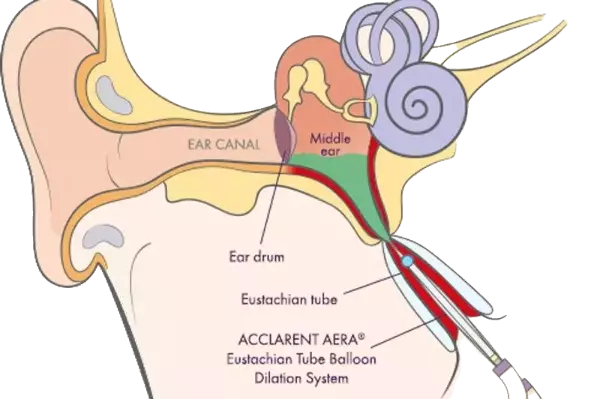What Is Eustachian Tube Dysfunction?
Home | Services | Ear, Hearing Loss & Audiology | What Is Eustachian Tube Dysfunction?
What Is Eustachian Tube Dysfunction (ETD)?
Eustachian tube dysfunction (ETD) is a condition where the eustachian tube is blocked or does not open properly. Air cannot then get into the middle ear, leading to a difference in pressure between the the outer side of the eardrum becomes and the air pressure in the middle ear. This pushes the eardrum inward. The eardrum becomes tense and does not vibrate so well when hit by sound waves, resulting in a sensation of decreased hearing
What Is The Eustachian Tube & What Does It Do?
 The eustachian tube is a narrow tube that connects the middle ear space with the back of the nose and throat. In adults it is about 3-4 cm long. The middle ear space is normally filled with air. The air in the middle ear is constantly being absorbed by the cells that line the middle ear and fresh supplies of air are routed to the middle ear via the eustachian tube.
The eustachian tube is a narrow tube that connects the middle ear space with the back of the nose and throat. In adults it is about 3-4 cm long. The middle ear space is normally filled with air. The air in the middle ear is constantly being absorbed by the cells that line the middle ear and fresh supplies of air are routed to the middle ear via the eustachian tube.
The eustachian tube is normally closed but opens from time to time when we swallow, yawn or chew. This allows air to flow into the middle ear and any mucus to flow out. This also keeps the air pressure equal on either side of the eardrum. Having equal air pressure on each side of the eardrum and keeping the middle ear free of mucus enables the eardrum to work and vibrate properly, resulting in normal hearing.
What Are The Symptoms Of Eustachian Tube Dysfunction?
The main symptom is muffled or dulled hearing, similar to what is experienced when an airplane is ascending or descending. Other symptoms include:
- Pain in the ear, as the eardrum is tensed and stretched.
- Feeling of fullness in the ear or ear canals
- Ringing or buzzing in the ear (tinnitus)
- Dizziness
One or both ears may be affected by this condition. Symptoms can also last from a few hours to several weeks or more, depending on the root cause. The ear canals should also be checked to eliminate ear wax as a cause of muffled or dulled hearing.
As symptoms are easing there may be popping sensations or noises in the ear. In addition, the muffled hearing may come and go for a short time before getting fully back to normal.
What Are Some Causes Of Eustachian Tube Dysfunction?
ETD occurs if the eustachian tube becomes blocked, if the lining of the tube becomes swollen or if the tube does not open as it should to allow air to travel to the middle ear space. Some common causes include:
Sinus Infections / Common Cold / Upper Respiratory Tract Infections
This is the most common cause of ETD. The thick mucus that develops during a cold or other infections may block the eustachian tube outlet. An infection may also cause the lining of the eustachian tube to become inflamed and swollen, and even cause middle ear infections.
Most people will have had one or more episodes in their life when they have had a cold and find that they cannot hear so well due to ETD. These symptoms may persist for up to a week or so (sometimes longer) after the other symptoms of the infection have gone, as the trapped mucus and swelling may take time to clear.
Allergies
Allergies that affect the nose such as allergic rhinitis and hay fever can cause extra mucus and inflammation in and around the eustachian tube.
Blockage
Anything that obstructs the eustachian tube can cause ETD. These include enlarged adenoids, and in some rare cases, tumors of the back of the nose.
How Is Eustachian Tube Dysfunction Treated?
Often no treatment is needed – especially after a upper respiratory tract infection, the condition is mild and does not last longer than a few days or a week or so. Some conservative treatment for eustachian tube dysfunction can be attempted, as follows:
Try to get air to flow into the Eustachian tube
Air is more likely to flow in and out of the Eustachian tube if you swallow, yawn or chew. Patients who go scuba diving will be familiar with equalization; or the Valsalva maneuver which may also be performed in an attempt to open the eustachian tube. The sequence is as follows:
- Take a breath in
- Then try to breathe out gently out through your nose with your mouth closed and with the nostrils pinched at the same time. In this way, no air is blown out of the nose or mouth, but air is being pushed into the eustachian tube into the middle ear space.
- You may feel your ears go ‘pop’ as air is forced into the middle ear; and this sometimes eases the problem.
- This can be repeated as many times as necessary, without fear of damaging the eardrum.
Antihistamine tablets / Intranasal steroid nasal sprays
In cases of ETD secondary to allergies, these, will help to ease nasal congestion, inflammation and amount of mucus production.
If conservative treatment fails, there are surgical options. A catheter can be used to insert a small balloon through the nose and into the eustachian tube. The balloon is then inflated, opening up (dilating) a pathway for mucus and air to flow more normally, helping to restore proper Eustachian tube function. It is deflated after balloon dilation and then removed.

Frequently Asked Questions
How Does Air Travel Affect The Eustachian Tube?
Some people develop ear pain when the plane descends to land. This is caused by unequal pressure that develop on either side of the eardrum as the plane descends.
As a plane descends the air pressure becomes higher nearer the ground. This pushes the eardrum inwards which can be painful. In most people just normal swallowing and chewing quickly cause air to travel up the Eustachian tube to equalize the pressure.
Can You Fly With Eustachian Tube Dysfunction?
Flying should be no issue with this condition. However, it may be beneficial to regularly perform the Valsalva maneuver (described above), wriggle your jaw, or chew gum to try to relieve the pressure in the middle ear especially when ascending and descending in the airplane.
Can A Tooth Infection Cause Eustachian Tube Dysfunction?
A tooth infection, especially one of the upper teeth, may produce symptoms similar to that of ETD. If the infection is severe enough and localized to a specific area, it may cause swelling in an around the jaw joint (temporomandibular joint) or TMJ.
As the jaw joint is adjacent to the eustachian tube, this may press on the tube and cause it to be blocked. That being said, a tooth infection causing this condition is extremely rare and unlikely.
Can TMJ Cause Eustachian Tube Dysfunction?
The TMJ is adjacent to the eustachian tube. As a result, any issue related to the TMJ may cause swelling in and around the joint. This may spread to the tube, causing blockage and symptoms similar to that of eustachian tube dysfunction.
A dentist or oro-maxillo-facial surgeon may be consulted to assist in issues of the TMJ which may be causing the symptoms. Treatments such as physiotherapy and injections into the joint can also be performed to alleviate the condition, if it is ascertained to be due to a TMJ disorder.
Can Eustachian Tube Dysfunction Cause Neck Pain?
This condition mainly causes symptoms in the ear, such as blockage, a sensation of reduced hearing or a ringing sound in the ear. It does not generally cause symptoms in the neck such as pain, stiffness or soreness.
Does Sinus Rinse Help With Eustachian Tube Dysfunction?
Sinus rinse could possibly be making the condition worse. As the nasal rinse is used to wash the nose, some of the liquid makes its way to the back of the nose where the tube is. This liquid can actually go up the eustachian tube and end up in the middle ear, producing symptoms similar to eustachian tube dysfunction.
The solution, if use of a sinus rinse is required, is to try to irrigate the nose with less pressure to prevent such a situation from occurring.
How I Cured My Eustachian Tube Dysfunction
The key principles in curing eustachian tube dysfunction are the following:
- Control of allergies and reducing the severity of allergies and post nasal drip with medications such as a steroid nasal spray
- Eliminating the possibility of enlarged adenoids or growths at the back of the nose causing blockage of the tube
- Regular attempts at opening the tube via the Valsalva maneuver (described above)
- Time and patience
In some severe cases where this condition leads to fluid buildup in the middle ear or middle ear infections, a procedure can be performed to drain fluid from the middle ear.








